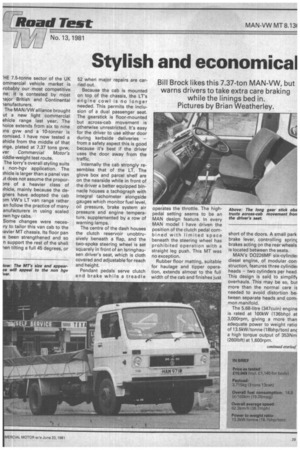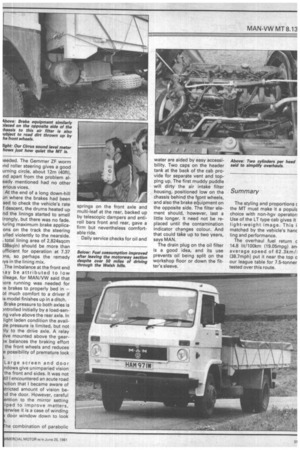Stylish and economical
Page 31

Page 32

Page 33

If you've noticed an error in this article please click here to report it so we can fix it.
HE 7.5-tonne sector of the UK ommercial vehicle market is orobably our most competitive ne; it is contested by most iajor British and Continental lanufacturers.
The MAN/VW alliance brought ut a new light commercial ehicle range last year. The hoice extends from six to nine ms gvw and a 10-tonner is romised. I have now tested a ahicle from the middle of that Inge, plated at 7.37 tons gvw, ver Commercial Motor's riddle-weight test route.
The lorry's overall styling suits
non-hgv application. The Micle is larger than a panel van Jt does not assume the proporDns of a heavier class of )hicle, mainly because the degners have adopted the cab Dm VW's LT van range rather an follow the practice of many anufacturers in using scaled )wn hgv cabs.
Some changes were necesry to tailor this van cab to the ).avier MT chassis. Its floor pan is been strengthened and so n support the rest of the shell -len tilting a full 45 degrees, or
52 when major repairs are carried out.
Because the cab is mounted on top of the chassis, the LT's engine cowl is no longer needed. This permits the inclusion of a dual passenger seat. The gearstick is floor-mounted but across-cab movement is otherwise unrestricted. It's easy for the driver to use either door during kerbside deliveries — from a safety aspect this is good because it's best if the driver uses the door away from the traffic.
Internally the cab strongly resembles that of the LT. The glove box and parcel shelf are on the nearside while in front of the driver a better equipped binnacle houses a tachograph with integral tachometer alongside gauges which monitor fuel level, oil pressure, brake system air pressure and engine temperature, supplemented by. a row of warning lamps.
The centre of the dash houses the clutch reservoir unobtrusively beneath a flap, and the two-spoke steering wheel is set squarely in front of an Isringhausen driver's seat, which is cloth covered and adjustable for reach and height.
Pendant pedals serve clutch and brake while a treadle operates the throttle. The highpedal setting seems to be an MAN design feature. In every MAN model I have driven the position of the clutch pedal combined with limited space beneath the steering wheel has prohibited operation with a straight leg push. This MT was no exception.
Rubber floor matting, suitable for haulage and tipper operation, extends almost to the full width of the cab and finishes just short of the doors. A small park. brake lever, controlling sprinç brakes acting on the rear wheels is located between the seats.
MAN's D0226MF six-cylinder diesel engine, of modular construction, features three cylinder heads — two cylinders per head, This design is said to simplify overhauls. This may be so, but more than the normal care is needed to avoid distortion between separate heads and common manifold.
The 5.68-litre (347cuin) engine is rated at 100kW (136bhp) at 3,000rpm, giving a more than adequate power to weight ratio of 13.5kW/tonne (18bhp/ton) anc a high torque output of 353Nm (260Ibft) at 1,600rpm.
The power train includes a 30mm (11 in) diameter hydrauliilly actuated clutch, a fiveDeed synchromesh gearbox ith power take-off points and a ngle-speed spur gear reducDn axle, with a ratio of 4.44 to 1 -id a capacity of 5.5 tonnes.
The direct top-gear ratio of 1 1 gave our short 3.1m (10ft in) wheelbased MT 8.136 iodel a top speed of 103km/h i4mph). First gear, with a ratio 16.67 to 1, allowed a restart on 1 in 4 gradient.
Three longer wheelbase opons are recommended for 3ulage operation. The longest, . 4.6m (15ft 1n), provides for Ddy lengths up to 6.22m (20ft n). The test vehicle, a model so recommended for tipper rork and equipped with a 4.77m 5ft 8inI aluminium drop-side oily built by Brade Leigh, gave body/payload capacity of 4.72 )nnes over the chassis-cab 'eight of 2.77 tonnes.
Entry to the cab is slightly obtructerl by the steering wheel, ut by using the grab handle laced on the vertical screen pilir and the two low, narrow teps in front of the wheel arch, followed as a natural and easy rogression to slide into the loth upholstered driving seat.
Vertical and horizontal adjust'lent give a wide choice of setngs to suit long or short-legged drivers. All the instrumentation can be seen clearly through the two-spoked steering wheel and, equally important, can be easily understood.
For cold weather starting, the first position of the key ignition activates a preheat glow plug. After a few seconds one of a row of dash-mounted warning lamps indicates that the required cylinder temperature has been reached.
It was not cold enough to need it on the morning we headed west along the M4 from Membury services. The six in-line diesel engine fired on the first turn of the key. Acceleration up to motorway cruising speeds was rapid.
The previous day at the Motor Industry Research Associations test track in the Midlands we recorded a 0 to 50mph time of just 36 seconds. A maximum speed in the mid-sixties left some throttle to spare when cruising at just below the legal limit — a speed which could be maintained up hill and down dale.
Rutting in the heavily trafficked slow lane of the M4 affected the MT's steering. The 7.5-tonner's track width is narrower than those of the heavier classes of vehicle responsible for most of the wear in the road structure.
As it was neither fully in nor out of the wheel tracks, the vehicle deviated from straightahead direction. Fortunately this "nibbling" effect was apparent only for short periods and did not unduly influence the motorway journey time, which was completed at a high average speed of 92.4km/h (57.4mph) accompanied by a little below average fuel consumption of 16.12 lit/100km (17.53mpg).
A comparatively low noise measurement of 78dBa, taken within a cab at motorway cruising speeds, might have been even better but for air whistling around the front of the cab. Later, at 40mph over the A-road section, our hand-held Cirrus sound-level meter read 73dBa when held at head height. , 30mph it read 10dBa less than showed at 60mph. Because the nature of the scale, tF means it was just about half noisy.
Over the whole of the A-roi section, which includes a tou( 50 miles of Welsh hills, the fL returns improved to a very cre itable 14.4 lit/100km (19.6mp( This was achieved despite a le from the non-standard lockir filler cap which persisted durir the test in its reluctance to seal
Power steering is an optior extra but at this weight is n seeded. The Gemmer ZF worm ind roller steering gives a good urning circle, about 12m (40ftl, nd apart from the problem aleady mentioned had no other erious vices.
At the end of a long down-hill
J n where the brakes had been sed to check the vehicle's rate f descent, the drums heated up nd the linings started to smell trongly, but there was no fade. luring maximum brake applicaons on the track the steering ulled violently to the nearside. . total lining area of 2,824sqcm t38sqin) should be more than ufficient for operation at 7.37 ans, so perhaps the remedy iys in the lining mix.
The imbalance at the front end lay be attributed to low iileage, for MAN/VW said that lore running was needed for le brakes to properly bed in — ot much comfort to a driver if is model finishes up in a ditch. Brake pressure to both axles is )1-strolled initially by a load-senng valve above the rear axle. In light laden condition the avail)le pressure is limited, but not ily to the driYe axle. A relay )Ive mounted above the gear
x balances the braking effort the front wheels and reduces e possibility of premature lock Large screen and door ndows give unimparied vision the front and sides. It was not til I encountered an acute road ction that I became aware of tricted amount of vision bed the door. However, careful ention to the mirror setting Iped to improve matters, erwise it is a case of winding door window down to look he combination of parabolic springs on the front axle and multi-leaf at the rear, backed up by telescopic dampers and antiroll bars front and rear, gave a firm but nevertheless comfortable ride.
Daily service checks for oil and water are aided by easy accessibility. Two caps on the header tank at the back of the cab provide for separate vent and topping up. The first muddy puddle will dirty the air intake filter housing, positioned low on the chassis behind the front wheels, and also the brake equipment on the opposite side. The filter element should, however, last a little longer. It need not be replaced until the contamination indicator changes colour. And that could take up to two years, says MAN.
The drain plug on the oil filter is a good idea, and its use prevents oil being split on the workshop floor or down the fitter's sleeve.
Summary
The styling and proportions c the MT must make it a populz choice with non-hgv operator! Use of the LT type cab gives it light-weight image. This i matched by the vehicle's hanc ling and performance.
The overhaul fuel return c 14.8 lit/100km (19.05mpg) am average speed of 62.3km/I (38.7mph) put it near the top co our league table for 7.5-tonner tested over this route.








































































































